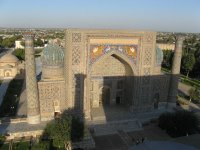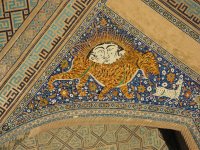 Samarkand was, for me, one of those "must-see" places on this planet. Photos of the Registan and the stories of the Amir Timur empire drew me here with aniticipation. One of Central Asia's oldest settlements, Samarkand was probably founded in the 5th century BC. It was already the cosmopolitan, walled capital of Sogdian empire when it was taken in 329 BC by Alexander the Great, who said, 'Everything I have heard about Marakanda (Greek name for Samrkand) is true, except that it's more beautiful then I ever imagined.' A key Silk Road city, it sat on the crossroads leading to China, India and Persia, bringing in trade and artisans. From the 6th to the 13th century it grew into a city more populous than it is today, changing hands every couple of centuries: Western Turks, Arabs, Persian Samanids, Karakhanids, Seljuq Turks, Mongolian Karakitay and Khorezmshah have all ruled here- before being literally obliterated by Jenghiz Khan in 1220.This might have been the end of the story, but in 1370 Timur decided to make Samarkand his capital, and over the next 35 years forged a new, almost-mythical city, Central Asia's economic and cultural epicentre. His grandson Ulughbek ruled until 1449 and made it an intellectual centre as well.
Samarkand was, for me, one of those "must-see" places on this planet. Photos of the Registan and the stories of the Amir Timur empire drew me here with aniticipation. One of Central Asia's oldest settlements, Samarkand was probably founded in the 5th century BC. It was already the cosmopolitan, walled capital of Sogdian empire when it was taken in 329 BC by Alexander the Great, who said, 'Everything I have heard about Marakanda (Greek name for Samrkand) is true, except that it's more beautiful then I ever imagined.' A key Silk Road city, it sat on the crossroads leading to China, India and Persia, bringing in trade and artisans. From the 6th to the 13th century it grew into a city more populous than it is today, changing hands every couple of centuries: Western Turks, Arabs, Persian Samanids, Karakhanids, Seljuq Turks, Mongolian Karakitay and Khorezmshah have all ruled here- before being literally obliterated by Jenghiz Khan in 1220.This might have been the end of the story, but in 1370 Timur decided to make Samarkand his capital, and over the next 35 years forged a new, almost-mythical city, Central Asia's economic and cultural epicentre. His grandson Ulughbek ruled until 1449 and made it an intellectual centre as well.The Registan is an awesome sight towering over a plaza just east of central Samrkand (and fantastically just 400m or so from my guesthouse). The first visit one evening, I approched from the side where I spotted a small wooden gate. I opened it and went through after which I was approcahed by a police guard who explained I should use the main entrance a few hundred metres away on the main plaza, but as it was late let me in and immediately ushered me to one of the minarets which although officially closed to the public, could be climbed for around 2 dollars. It was a very, very narrow winding staircase of steep steps and tough on the legs, but gave great views of the Sher Dor (Lion) Medrassa and the Tilla Kari (gold-covered) medrassa.
The next day, a more extensive visit consisted of viewing all three medrassas which unsurprisingly now housed many small souvenier and art shops run by ladies who were always keen to grab your attention and drag you in. Admittedly, there were some very nice carpets, materials and paintings available and if I was on a short trip instead of a tour with a backpack I would easily have bought many beautiful things there.


Left: The Sher Dor Medrassa.
Right: Close-up of the lion on the Sher Dor.


Left: Inside the Ulughbek Medrassa.
Right: Decorated Ceiling inside the Tilla Kari medrassa.
The Bahordir guesthouse here was full of independent travellers like myself and confirmed further what had become apparent so far, that the only nationalities travelling these parts were either French, German, Swiss or Japanese, with the very occassional Israeli & Dutch thrown in. I had travelled along from Khiva via Bukhara with two Japanese (Yuta and Ikiko) and funnily at one point I was sat at dinner with them and 6 other Japanese ladies, all of who were travelling alone, Ikiko said it reminded her of 'Lost in Translation'.
Some Samarkand guides will call the city the 'Centre of the World', well while studying a map with Yuta and Ikiko to show them where in Wales I was born, it turned out that from my hometown of Haverfordwest, it was virtually the same distance as the crow flies to Samrkand as it was to their home town, Tokyo. Wales is almost as far West as you can get in Europe and Japan is as far East as you can go in Europe/Asia, for us, at that moment, Samarkand certainly was the 'Centre of the world'
While in Samrkand I also had one of the strangest 'Hot Dogs' ('Хот дог' is the amusing Russian translation) ever. The sausage was fine, the bread was fine, but has anyone else ever had one with grated carrot, grated purple cabbage and pickle smothered in mayonnaise before ?



No comments:
Post a Comment